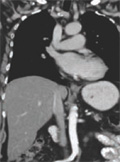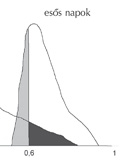The eLitMed.hu medical portal uses computer cookies for convenient operation. Detailed information can be found in the Cookie-policy.
Lege Artis Medicinae - 2011;21(12)
Content
[Thyroid disorders during pregnancy]
[The hormones of the thyroid gland play a basic role in human reproduction and in the early development of the fetal brain, too. The frequency of hypo- and hyperthyroidism occuring in a pregnancy is between 1-2 per cent. Abnormal maternal thyroid function could result in harmful effects for both the mothers and their offsprings. An illness (gestational throphoblast disease) that is known to have an influence on the maternal thyroid function. Thyroid diseases occuring in pregnancy can result in diagnostical problems: the existing complaints and symptoms may be misdiagnosed as a consequence of pregnancy. Because of the changes in thyroid metabolism, which are typical to pregnancy, the analysis of the results of thyroid function may be difficult. Several diagnostical and therapeutical procedures (i. e. radioiodine techniques) are absolutely contraindicated during pregnancy. In the case of thyroid hormone replacement therapy one must take into consideration the continously changing maternal demand. Propylthiouracil is the choice of therapy regarding the treatment of the hyperthyreoidism during pregnancy. The incidence of thyroid cancer in pregnancy is 1 per 1000. Pregnancy itself does not appear to increase the risk of malignant tranformation or alter the course of thyroid cancer. The preferred period of the surgical intervention of the thyroid gland is the second trimester of the pregnancy. The introduction of a thyroid functional test (thyroid-stimulating hormone) as a screening method in the first trimester would be advisable in our country. Achieving this new procedure would reflect and expand a way of thinking in respect of prevention in our pregnancy care practice.]
[The newest DPP-4-inhibitor: linagliptin]
[Linagliptin is a xantin-based, highly selective, potent inhibitor of dipeptidyl peptidase- IV (DPP-4). By inhibiting DPP-4, linagliptin reduces the degradation of endogenous incretin hormones, and thus increases insulin secretion and decreases glucagon secretion in the pancreatic islets in a glucose-dependent manner. The author summarises the most important clinical trials with linagliptin, which highlight those features of linagliptin that distinguish it from other DPP-4 inhibitors.]
[Oxytocin as a neurotransmitter: beyond the peripheral scope]
[Besides its effect on the uterus and breasts, oxytocin also regulates affiliative behaviour. The so-called central oxytocin effect influences pair bonding, maternal care and attachment through the regulatory functions of oxytocin that acts as a neurotransmitter within the brain. The central oxytocin effect increases trust and social support, decreases fear and anxiety, and promotes wound healing. These effects form the basis of the stress-triggered, oxytocin-based ‘calm and connection’ reaction. Some methods that are widely used in modern obstretric practice - such as the use of synthetic oxytocin for inducing or speeding up labour or epidural anaesthesia - hinder the psycho-emotive effects that are based on natural oxytocin. Epigenetic studies performed in animals indicate that the oxytocin effect experienced at birth can be transgenerational.]
[The choice of antibiotic therapy from the viewpoint of an economist]
[OBJECTIVES - Antimicrobial resistance (AMR) in various bacterial infections is a growing problem in everyday clinical practice. The development of resistance is related to the clinical use of antibiotics, which substantially influences the efficiency of antimicrobial therapy. Inappropriately chosen therapy may increase the cost of treatment because of reduced efficacy and potential unwanted outcomes, adverse effects. Prolonged duration of treatment and increased use of diagnostic and therapeutic resources (including all medication expenses) contribute to the increased costs of treatment. The aim of our study was to demonstrate the differences in the total cost of therapy during hospitalization in certain patient groups, depending on the efficiency of the chosen antibiotic therapy. METHODS - We examined acute abdominal episodes, which represent one of the most typical surgical diseases. We analysed 59 hospital in-patient episodes that occurred in a six-month period, using aggregated hospital data. On the basis of the first choice of antibiotic we compared the average duration of antibiotic therapy and hospital stay, the incidence of medical complications and the cost of all these factors. RESULTS - The available results of our pilot study show that the length of hospital stay and the total cost of treatment may substantially increase even in the short term as a result of an inadequate choice of antibiotic, as the total cost of treatment is affected not only by the daily cost of antibiotic therapy, but also by its efficiency. In the long term, the risk of potentially developing resistance also necessitates an accurate choice of therapy, which requires institutional infection control and the prescription and implementation of protocols. These must be supported by cost-effectiveness analyses that include costs as well as results.]
[Occurrence of cardiometabolic risk factors among shift workers]
[INTRODUCTION - Shift workers have an impaired circadian rhythm, which might have an adverse effect on their health. In order to assess cardiometabolic risk in shift workers, a cross-sectional study was performed among active workers (aged 25-66 years, with a minimal shift working experience of 5 years). METHODS - In total 481 workers (121 men, 360 women) registered by the occupational health service were enrolled in our study. Most participants worked in the light industry (58.2%) or in public service (23.9%). Following questionnaire-based data recording, anthropometric measurements and physical examination were performed and fasting venous blood sample was taken for measuring laboratory parameters. Data from shift workers (n=234, 54 men and 180 women, age: 43.9±8.1 years) were compared with those of day workers (n=247, 67 men and 180 women, age: 42.8±8.5 years). RESULTS - Compared with day workers, shift workers had bigger weight (76.6±16.1 vs 73.9±17.6 kg; p<0.05), higher BMI index (27.5±5.3 vs 26.0±4.9 kg/m2; p<0.01) and systolic blood pressure (123±19 vs 119±16 mmHg, p<0.01), and higher prevalence rate of diabetes (4.3 vs 1.2 %; p<0.05) and cardiovascular diseases (3.8 vs 0.8 %; p<0.05). In addition, the proportion of participants who performed regular physical activity was lower (20.6 vs 38.7 %; p<0.001) and that of current smokers were higher (35.0 % vs 19.5 %; p<0.001) in shift workers than in day workers. In laboratory findings, only one difference has been found: HDL-cholesterol level was lower among women (shift workers versus workers: 1.56±0.32 vs 1.68±0.36 mmol/l; p<0.01). CONCLUSION - Long-term shift work (day-night) results in a less healthy lifestyle and worse cardiometabolic risk factors compared with day work. Thus, our study highlights the importance of measures for preventing cardiovascular diseases in shift workers.]
1.
Clinical Neuroscience
Is there any difference in mortality rates of atrial fibrillation detected before or after ischemic stroke?2.
Clinical Neuroscience
Factors influencing the level of stigma in Parkinson’s disease in western Turkey3.
Clinical Neuroscience
Neuropathic pain and mood disorders in earthquake survivors with peripheral nerve injuries4.
Journal of Nursing Theory and Practice
[Correlations of Sarcopenia, Frailty, Falls and Social Isolation – A Literature Review in the Light of Swedish Statistics]5.
Clinical Neuroscience
[Comparison of pain intensity measurements among patients with low-back pain]1.
Clinical Neuroscience Proceedings
[A Magyar Stroke Társaság XVIII. Kongresszusa és a Magyar Neuroszonológiai Társaság XV. Konferenciája. Absztraktfüzet]2.
3.
Journal of Nursing Theory and Practice
[A selection of the entries submitted to the literary contest "Honorable mission: the joys and challenges of our profession" ]4.
Journal of Nursing Theory and Practice
[End of Life and Palliative Care of Newborns in the Nursing Context]5.
Journal of Nursing Theory and Practice
[Aspects of Occupational Health Nursing for Incurable Patients ]















